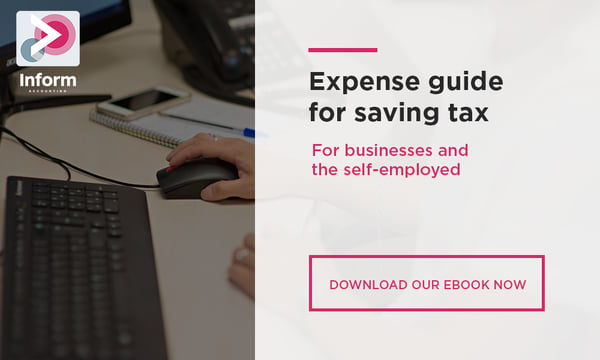BLOG ADVISORY & BUSINESS SUPPORT
Creating your annual budget can be as easy as 1...2...3...
Budgeting is one of those terms that can either get you excited for the future, or sound like a drain on your time. We believe every business, no matter how small, should have at least a 12 month budget to support their business plan.
So with our glasses half full, we wanted to impart some of our knowledge by creating a quick and easy three step process to get you started on creating your budget for the next financial year. And with the effects of COVID crippling a number of businesses, what better reason is there to create your ‘survival’ budget.
1. Headline numbers
The easiest place to start is usually focussing on your target sales and profit figures for the year. Most businesses work to a particular gross margin e.g. 20%, 40% etc. If you’re not sure what margins you should be working to, take a look at your competitors to see what they’re doing - industry benchmarking can be useful as a starting point.
Revenue
You’ll need to plot out your revenue figures on a month-by-month basis. There are two thoughts to this:
Trended sales
If your sales are typically trended, take a look at the last financial year to see when your sales peaked, and when they fell. It’s likely that they’ll do the same this year, so take this into account when allocating your revenue target to each month.
Non-trended sales
You may find that splitting your annual revenue target equally over 12 months works just fine.
Cost of Sales
Your next big figure that will affect your profits is your cost of sales. A simple way of calculating this if you’re working towards a set margin is: Revenue x (100% - target gross profit margin %)
For example, if you’ve set your revenue target for the month at £50,000, and you’re working towards a margin of 30%, this means you’re expecting a gross profit of £15,000 (£50,000 x 30%). So your cost of sales must be £35,000. This is the same as saying (£50,000 x (100% - 30%)).
Alternatively, if you have a number of costs making up your cost of sales, you may want to go through and budget for each cost individually.
Net Profit
Before you begin to look at all your other costs, it is important to set your target net profit. This will help guide how much you can afford to spend, and end up with the amount you want to retain as profits. Again, benchmarking against other similar companies might be a good start here.
2. Go through your figures with a fine tooth comb
Great, you’ve got your headline numbers, but now it’s time to get into the nitty gritty.
By now you’ve either split your sales evenly, or worked out a trend. But if you’ve got multiple sales channels or split your sales by type, you now need to split out the sales you’ve allocated to that month into these different sales items. This is the same for your cost of sales. It might be worth setting up different tabs for each, so you can easily see all your workings, and you can include as much detail as you want.
The next key step is to start thinking about what your next year looks like in terms of your business development plans. If you’re expecting to grow, how are you going to do it?
- New employees - remember to include all the associated costs of recruitment, salaries, benefits etc.
- Increased marketing - will these be phased leading up to sales campaigns? Timing is usually an important factor to consider here.
You may realise as you start to think about your plans that your initial targets need adjusting. Budgeting isn’t an exact science; adjust these targets accordingly so they are realistic in line with your plans.
Operating Expenses
This is usually the bit that takes the longest, but it needn’t. As a business owner, you generally have a good idea of what expenses you have, how much you usually spend, contracts in place, and when you anticipate incurring any future expenses.
Plot your regular fixed costs first, as these will be the easiest. Now that you’ve got the ball rolling, start to think about what other costs you usually incur, and start to plot them in.
If you're struggling, look at your expenses from last year for a source of comparison. Are the figures that you’ve put in for this year significantly different - if so why?
3. Take a birds eye view
Now that you’ve got your first draft of your annual budget, take a step back and look at it from a high level. Ask yourself the following questions:
- Do the figures make sense e.g. does revenue grow in line with planned sales campaigns?
- Does it look realistic and achievable, whilst still presenting a challenge for your team?
- Will your existing team be able to meet the revenue targets you’ve set each month?
- Will this budget help you to meet your goals, whether growth, freeing up your time, increasing your wealth etc?
If the answer to these questions is no, then you’ve got some more work to do.
If the answer is yes, then fantastic! You need to communicate the new budget with your team to make sure it’s fully understood, and everyone is working towards the same goal. Goal congruence is absolutely essential to ensuring you’re on the right track to meeting your development plans. You may want to set up a reward scheme for your team to encourage them to meet their targets.
If you prepare management accounts, make sure you upload your budget to your accounting software so you can report performance against targets.
Need help with your budget?
If you’re struggling to get to grips with your budget and need support, get in touch with us today on (0121) 667 3882 or email us at hello@informaccounting.co.uk to find out how we can help.
Read more of Inform's tax blogs:
Live page: Accounting advice during business disruption
It's that wonderful time of the year...for fraudsters to pray on taxpayers!
Paying yourself a salary: What are the most tax efficient options for limited company owners?
Four key cashflow issues that could cripple your business (and how to avoid them)...




.jpg?width=1500&height=1000&name=amy-hirschi-K0c8ko3e6AA-unsplash-(5).jpg)

